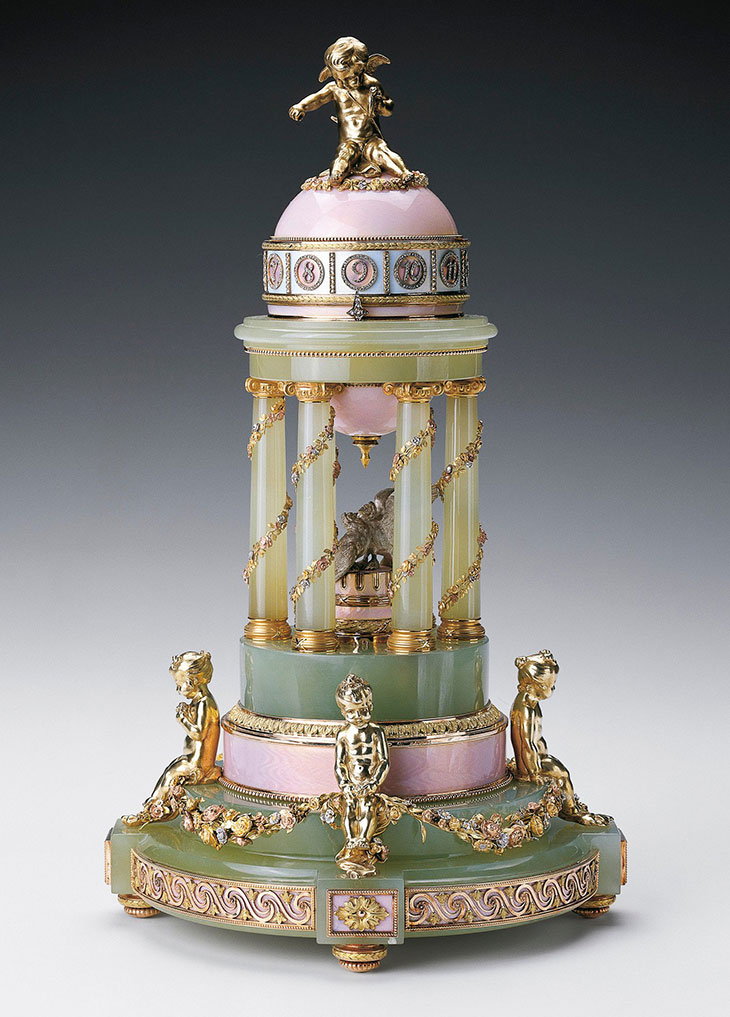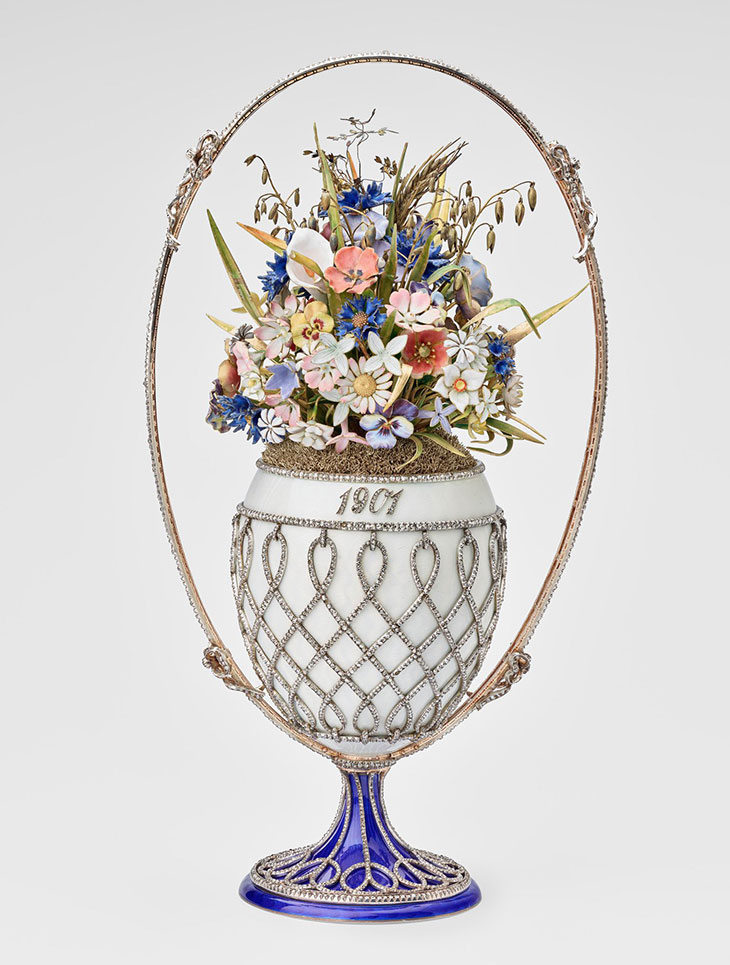‘You are an incomparable genius,’ Maria Feodorovna, Dowager Tsarina of Russia, told the goldsmith and jeweller Peter Carl Fabergé in the spring of 1914. Posterity has endorsed the empress’s verdict enthusiastically. As it did in Fabergé’s lifetime, the output of the St Petersburg-based business he inherited from his father, which consisted of a number of rigorously supervised workshops, has continued to mesmerise subsequent generations. No wonder, then, that any dispute over authenticity will have an inflammatory effect, as seen in the recent controversy over a number of objects in the Hermitage exhibition ‘Fabergé: Jeweller to the Imperial Court’ (in an open letter to its director, the art dealer Andre Ruzhnikov has accused the museum of displaying ‘a number of outright fakes’).
The hold that Fabergé exercises over the popular imagination is unlikely to abate – or indeed to suffer eclipse. Vertiginously deep pockets on the part of the company’s original clients and Carl Fabergé’s own exacting standards imposed on every craftsman in his employ – including those who made by hand the velvet- or silk-lined wooden boxes in which pieces were sold – sought to guarantee workmanship of exceptional quality. Fabergé himself insisted on the finest materials: hardstones such as rhodonite, jasper, nephrite and bowenite mined in Russia; and each painstaking stage of production was supervised and scrutinised. The items sold by Fabergé between 1885, the year in which the company received from Alexander II the warrant ‘Goldsmith by Special Appointment to the Imperial Crown’, and 1918, when production ended in the wake of the Russian Revolution, targeted a rarefied and sophisticated clientele centred on the imperial family and their court.
For a century, our knowledge of impending tragedy has invested Fabergé’s bibelots with dark romance. Like Sèvres porcelain, Rose Bertin’s preposterous millinery or Jean-Henri Riesener’s gorgeous, ormolu-mounted furniture in pre-Revolutionary France, Fabergé jewels and objets de vertu represent a last glittering efflorescence of court culture before the deluge of revolution, in this case following the bloodbath of the First World War. Of the company’s principal patrons in Russia, only Maria Feodorovna escaped the 1917 Revolution with her life.
The Dowager Tsarina had been born a Danish princess; her sister Alexandra married the future Edward VII. This family relationship between the Russian and British courts accounted for Fabergé’s principal overseas market. In 1903, Fabergé opened a shop in London chiefly patronised by the royal family and their immediate circle. The sisters’ families exchanged Fabergé gifts, like a cigarette box in three colours of gold, decorated with a crowned cipher made up of the initials ‘E’ and ‘A’ in diamonds, which Maria Feodorovna gave Edward VII as a 40th wedding anniversary present in 1903.
Many surviving Fabergé pieces have a personal quality of this sort that adds poignancy to their beauty and ingenuity; their narrative is the story of relationships within the imperial family. In the early summer of 1894, for example, the future Nicholas II purchased from Fabergé, for the considerable sum of 1,100 roubles, a brooch consisting of a large aquamarine within a latticework of diamonds. It was an engagement present for his fiancée, Alix of Hesse, who kept it with her even in imprisonment in Ekaterinburg. Sixteen years later, Nicholas presented Alix with the neoclassical-style Colonnade Egg, now in the Royal Collection. It commemorated the long-awaited birth of their son, Alexei, in 1904, and the completion of the couple’s family. The baby Tsarevitch is represented as a gold amorino, the couple’s four daughters as putti around the model’s base.

The Colonnade Egg (1910), Henrik Immanuel Wigström for Fabergé. Royal Collection Trust/© Her Majesty Queen Elizabeth II 2021
Fabergé represents the elevation of style to an art form. Even a humble gardening knife underwent a fairy-tale transformation in Fabergé’s workshops, its translucent hardstone handle crisply carved into the form of a snail on a stalk, the whole gorgeous confection bound to the knife’s blade with a gold-mounted enamel collar. Little wonder the company’s output consistently delighted history’s magpies, from King Farouk of Egypt and the Indian princes who shopped at Fabergé in London to American plutocrats and, especially, their wives and daughters. And, of course, Queen Mary, who, after the Russian Revolution, continued to add to the collection of Fabergé assembled by her parents-in-law, Edward VII and Queen Alexandra. Whether or not George V’s jewel-loving consort experienced any qualms in acquiring imperial booty plundered by the Soviets, there can be no doubt that the Royal Collection benefited from her enthusiasm. Today, extending to nearly 600 pieces, the Fabergé collection within the Royal Collection is the world’s largest – and maintains the snob factor that Carl Fabergé so assiduously marketed in imperial Russia, which is not least among Fabergé’s glittering attractions.

Basket of flowers egg (1901), Fabergé; acquired by Queen Mary in 1933. Royal Collection Trust/© Her Majesty Queen Elizabeth II 2021

Thoroughly good eggs: how Fabergé became the last word in luxury
Shell company: Queen Elizabeth II is presented with a Fabergé-style egg by the Sultan of Oman in 2010. John Stillwell/Getty Images
Share
‘You are an incomparable genius,’ Maria Feodorovna, Dowager Tsarina of Russia, told the goldsmith and jeweller Peter Carl Fabergé in the spring of 1914. Posterity has endorsed the empress’s verdict enthusiastically. As it did in Fabergé’s lifetime, the output of the St Petersburg-based business he inherited from his father, which consisted of a number of rigorously supervised workshops, has continued to mesmerise subsequent generations. No wonder, then, that any dispute over authenticity will have an inflammatory effect, as seen in the recent controversy over a number of objects in the Hermitage exhibition ‘Fabergé: Jeweller to the Imperial Court’ (in an open letter to its director, the art dealer Andre Ruzhnikov has accused the museum of displaying ‘a number of outright fakes’).
The hold that Fabergé exercises over the popular imagination is unlikely to abate – or indeed to suffer eclipse. Vertiginously deep pockets on the part of the company’s original clients and Carl Fabergé’s own exacting standards imposed on every craftsman in his employ – including those who made by hand the velvet- or silk-lined wooden boxes in which pieces were sold – sought to guarantee workmanship of exceptional quality. Fabergé himself insisted on the finest materials: hardstones such as rhodonite, jasper, nephrite and bowenite mined in Russia; and each painstaking stage of production was supervised and scrutinised. The items sold by Fabergé between 1885, the year in which the company received from Alexander II the warrant ‘Goldsmith by Special Appointment to the Imperial Crown’, and 1918, when production ended in the wake of the Russian Revolution, targeted a rarefied and sophisticated clientele centred on the imperial family and their court.
For a century, our knowledge of impending tragedy has invested Fabergé’s bibelots with dark romance. Like Sèvres porcelain, Rose Bertin’s preposterous millinery or Jean-Henri Riesener’s gorgeous, ormolu-mounted furniture in pre-Revolutionary France, Fabergé jewels and objets de vertu represent a last glittering efflorescence of court culture before the deluge of revolution, in this case following the bloodbath of the First World War. Of the company’s principal patrons in Russia, only Maria Feodorovna escaped the 1917 Revolution with her life.
Cigarette case (1903), Fabergé. Royal Collection Trust/© Her Majesty Queen Elizabeth II 2021
The Dowager Tsarina had been born a Danish princess; her sister Alexandra married the future Edward VII. This family relationship between the Russian and British courts accounted for Fabergé’s principal overseas market. In 1903, Fabergé opened a shop in London chiefly patronised by the royal family and their immediate circle. The sisters’ families exchanged Fabergé gifts, like a cigarette box in three colours of gold, decorated with a crowned cipher made up of the initials ‘E’ and ‘A’ in diamonds, which Maria Feodorovna gave Edward VII as a 40th wedding anniversary present in 1903.
Many surviving Fabergé pieces have a personal quality of this sort that adds poignancy to their beauty and ingenuity; their narrative is the story of relationships within the imperial family. In the early summer of 1894, for example, the future Nicholas II purchased from Fabergé, for the considerable sum of 1,100 roubles, a brooch consisting of a large aquamarine within a latticework of diamonds. It was an engagement present for his fiancée, Alix of Hesse, who kept it with her even in imprisonment in Ekaterinburg. Sixteen years later, Nicholas presented Alix with the neoclassical-style Colonnade Egg, now in the Royal Collection. It commemorated the long-awaited birth of their son, Alexei, in 1904, and the completion of the couple’s family. The baby Tsarevitch is represented as a gold amorino, the couple’s four daughters as putti around the model’s base.
The Colonnade Egg (1910), Henrik Immanuel Wigström for Fabergé. Royal Collection Trust/© Her Majesty Queen Elizabeth II 2021
Fabergé represents the elevation of style to an art form. Even a humble gardening knife underwent a fairy-tale transformation in Fabergé’s workshops, its translucent hardstone handle crisply carved into the form of a snail on a stalk, the whole gorgeous confection bound to the knife’s blade with a gold-mounted enamel collar. Little wonder the company’s output consistently delighted history’s magpies, from King Farouk of Egypt and the Indian princes who shopped at Fabergé in London to American plutocrats and, especially, their wives and daughters. And, of course, Queen Mary, who, after the Russian Revolution, continued to add to the collection of Fabergé assembled by her parents-in-law, Edward VII and Queen Alexandra. Whether or not George V’s jewel-loving consort experienced any qualms in acquiring imperial booty plundered by the Soviets, there can be no doubt that the Royal Collection benefited from her enthusiasm. Today, extending to nearly 600 pieces, the Fabergé collection within the Royal Collection is the world’s largest – and maintains the snob factor that Carl Fabergé so assiduously marketed in imperial Russia, which is not least among Fabergé’s glittering attractions.
Basket of flowers egg (1901), Fabergé; acquired by Queen Mary in 1933. Royal Collection Trust/© Her Majesty Queen Elizabeth II 2021
Unlimited access from just $16 every 3 months
Subscribe to get unlimited and exclusive access to the top art stories, interviews and exhibition reviews.
Share
Recommended for you
Luxury in exile – at Napoleon’s country villa on Elba
The Mediterranean island still bears the mark of its most famous one-time resident
Hedonism in Herculaneum – a guide to good living in a luxurious Roman villa
The Villa dei Papiri gives us a glimpse into the world of a Roman statesman and his interest in Epicurean philosophy
Russian spark – the palace builders of St Petersburg
A ritzy new book brings to life the eclectic tastes and unbridled opulence of aristocratic families in late imperial Russia